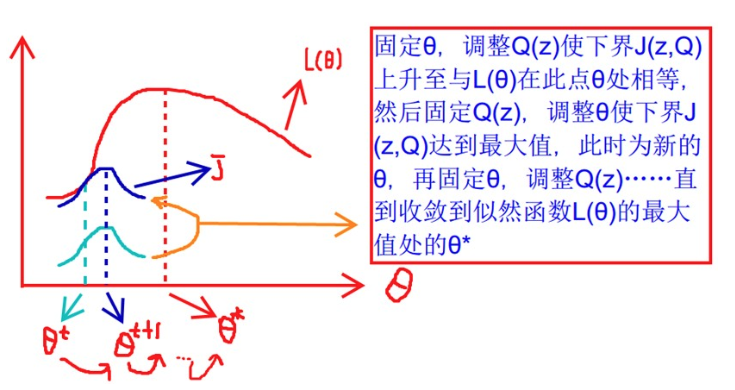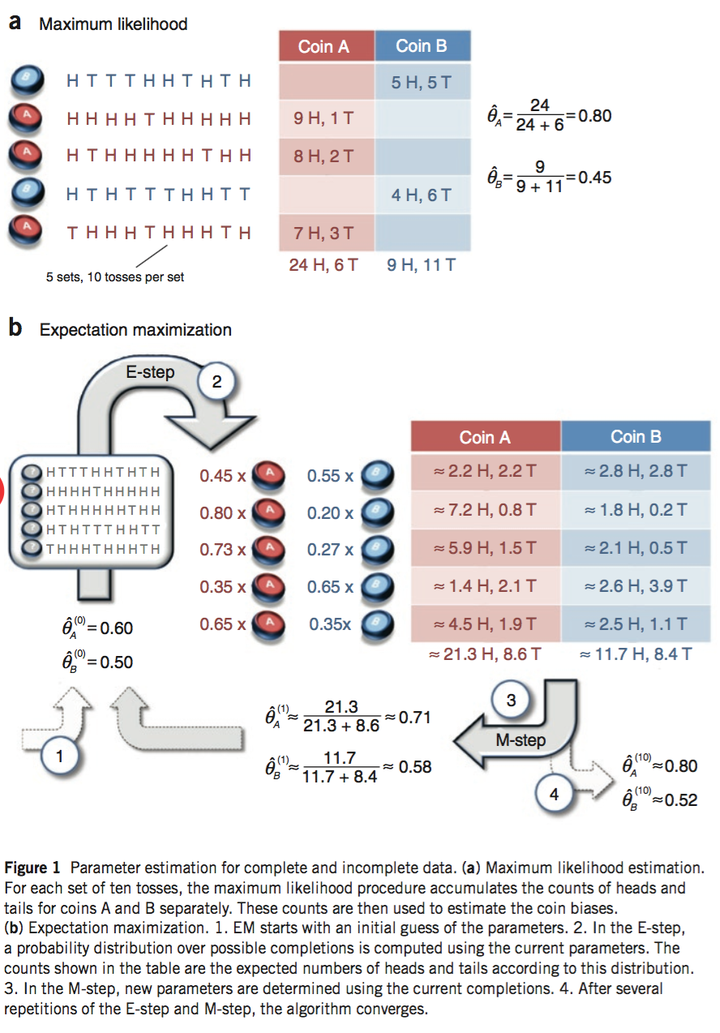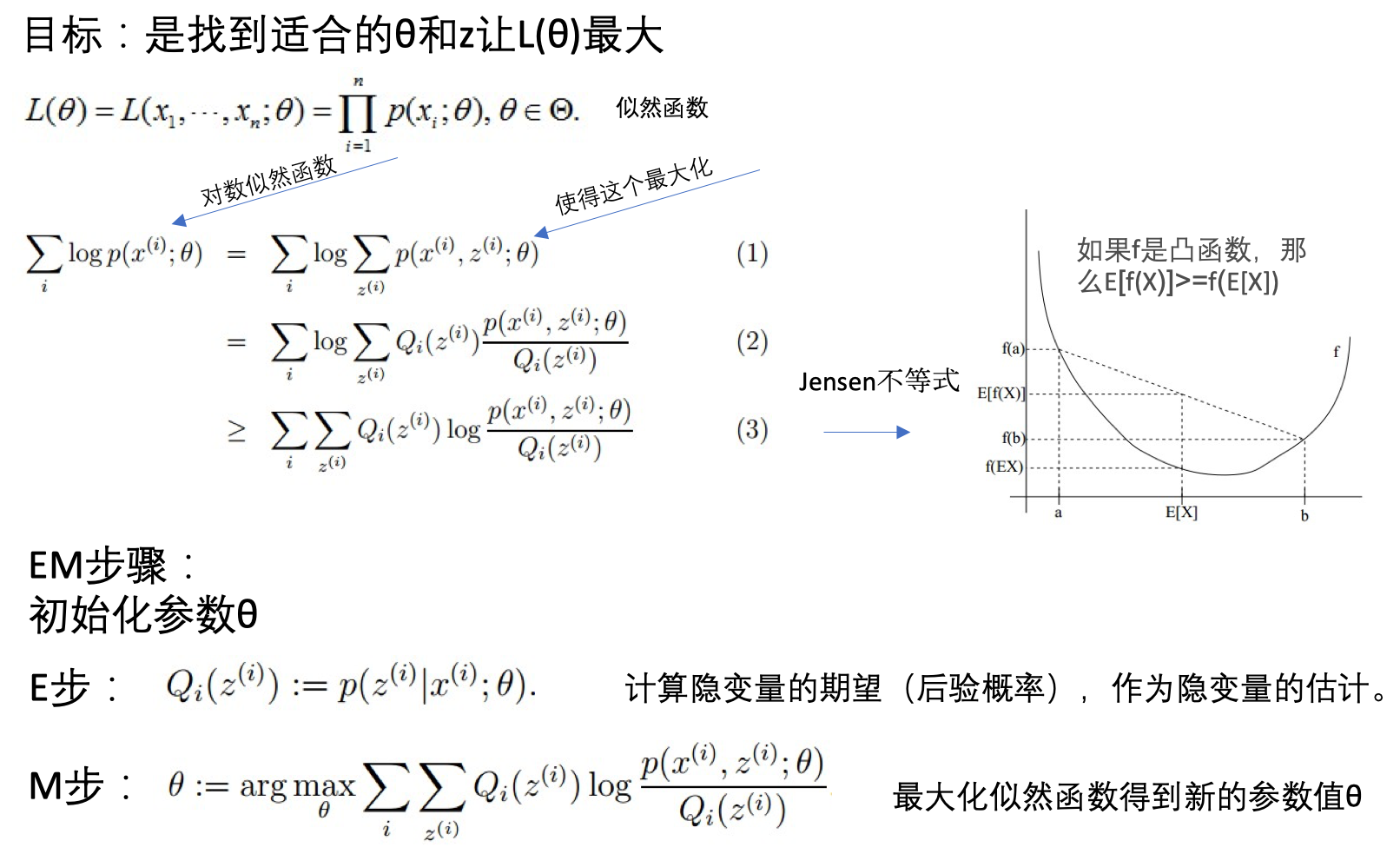目录
最大似然
最大似然的想法经常被用到
具体到这个例子中,有如下过程:
- 假设\(\theta\)为黑球的占比,所以\(\theta_甲=0.01\),\(\theta_乙=0.99\)
- 只取一次,只有1个样本,随机独立,所以每个样本服从\(p=\theta\)的伯努利分布
- 计算似然值(在不同\(\theta\)取值下,出现某个数据集的可能性):
- 甲箱:\(ln P_X(x_1,...,x_n;\theta_甲)=\sum_{i=1}^nln(x_i;\theta_甲)=ln(0.01)\)
- 乙箱:\(ln P_X(x_1,...,x_n;\theta_甲)=\sum_{i=1}^nln(x_i;\theta_甲)=ln(0.99)\)
- 所以最可能的是乙箱
调查学校男女生身高
- 抽样男生100,女生100,量取身高,左手边是男生,右手边是女生(注意:男女生分开)
- 假设男生女生身高服从高斯分布,但是分布的均值和方差未知
-
需要估计模型参数:即均值和方差
- 从分布是\(p(x\|θ)\)的总体样本中抽取到这100个样本的概率,也就是样本集X中各个样本的联合概率: \(L(\theta)=L(x_1,...,x_n;\Theta)=\prod p(x_i;\theta), \theta\subset\Theta\)
- 只有\(\theta\)是未知的,所以是\(\theta\)的函数
- 要使得\(L(\theta)\)取到最大值,值需要对\(\theta\)求导,求得导数=0时的\(\theta\)值即可。
- 函数:反应了在不同的参数\(\theta\)取值下,取的当前这个样本集的可能性,因此称为参数\(\theta\)相对于样本集\(X\)的似然函数。
最大似然的思想
- 内容:已知某个随机样本满足某种概率分布,但是其中具体的参数不清楚,参数估计就是通过若干次试验,观察其结果,利用结果推出参数的大概值。
- 思想:已知某个参数能使这个样本出现的概率最大,我们当然不会再去选择其他小概率的样本,所以干脆就把这个参数作为估计的真实值。
求最大似然函数估计值的一般步骤
- (1)写出似然函数;
- (2)对似然函数取对数,并整理;
- (3)求导数,令导数为0,得到似然方程;
- (4)解似然方程,得到的参数即为所求;
为什么需要EM算法?
- 最大似然估计的拓展
- 模型的数据不完备:比如某些属性值是缺失的
EM算法原理:期望最大化算法(Expectation-Maximization)
原理
- 若参数\(\Theta\)已知,则可根据训练数据集推断出最优隐变量\(Z\)的值(E步);反之,若最优隐变量\(Z\)的值已知,可方便的对参数\(\Theta\)做极大似然估计(M步)。
对模型参数\(\Theta\)做极大似然估计:
- 隐变量(latent variable):未观测的变量\(Z\)
- 已观测变量集:\(X\)
- 模型参数:\(\Theta\)
- 最大化对数似然:\(LL(\Theta\|X,Z)=lnP(X,Z\|\Theta)\)
- 问题:\(Z\)是隐变量,无法直接进行求解
先计算隐变量的期望,再估计模型参数:
- 解决:通过对\(Z\)计算期望,来最大化已观测数据的对数边际似然(marginal likelihood)
- 对数边际似然:\(LL(\Theta\|X)=lnP(X\|\Theta)=ln\sum_{Z}P(X,Z\|\Theta)\)
EM步骤两步
- 基于\(\Theta^t\)推断隐变量\(Z\)的期望,记为\(Z^t\)
- 基于已观测变量\(X\)和\(Z^t\)对参数\(\Theta\)做极大似然估计,记为\(\Theta^(t+1)\)
- 交替直到收敛
EM图解
- 固定\(\theta\),调整\(Q(z)\)使得下界\(J(z,Q)\)上升至于\(L(\theta)\)在此点\(\theta\)相等
- 然后固定\(Q(z)\),调整\(\theta\)使得下界\(J(z,Q)\)达到最大值(\(\theta^t\)到\(\theta^(t+1)\))
- 再固定\(\theta\),调整\(Q(z)\)。。。
- 直到收敛到似然函数\(L(\theta)\)的最大值处\(\theta^*\)

EM算法特点
- 估计隐变量参数
- 是迭代算法
EM算法例子
调查学校男女生身高:引入隐变量
- 抽样男生100,女生100,量取身高,但是男女生是在一起的。
- 假设男生女生身高分别服从高斯分布,但是对应分布的均值和方差未知
- 问题:随便指定一个身高,不知道是来自男生还是女生?
- 描述:抽取得到的每个样本都不知道是从哪个分布抽取的
- 所以这里既有有了隐变量:抽取得到的每个样本都不知道是从哪个分布抽取的
- 需要估计模型参数:即各自的均值和方差
抛硬币的例子
现在有两个硬币A和B,要估计的参数是它们各自翻正面(head)的概率。观察的过程是先随机选A或者B,然后扔10次。以上步骤重复5次。
- 如果知道每次选的是A还是B,那可以直接估计(见下图a)。
- 如果不知道选的是A还是B(隐变量),只观测到5次循环共50次投币的结果,这时就没法直接估计A和B的正面概率。EM算法此时可起作用(见下图b)。

抛两枚硬币模型的python实现
具体参考这里:
对于第一次的抛,测试输出是否和论文一致:
# 硬币投掷结果观测序列
observations = np.array([[1, 0, 0, 0, 1, 1, 0, 1, 0, 1],
[1, 1, 1, 1, 0, 1, 1, 1, 1, 1],
[1, 0, 1, 1, 1, 1, 1, 0, 1, 1],
[1, 0, 1, 0, 0, 0, 1, 1, 0, 0],
[0, 1, 1, 1, 0, 1, 1, 1, 0, 1]])
coin_A_pmf_observation_1 = stats.binom.pmf(5,10,0.6)
coin_B_pmf_observation_1 = stats.binom.pmf(5,10,0.5)
normalized_coin_A_pmf_observation_1 = coin_A_pmf_observation_1/(coin_A_pmf_observation_1+coin_B_pmf_observation_1)
# 更新在当前参数下A、B硬币产生的正反面次数
counts['A']['H'] += weight_A * num_heads
counts['A']['T'] += weight_A * num_tails
counts['B']['H'] += weight_B * num_heads
counts['B']['T'] += weight_B * num_tails
# 在初始化的theta下,AB分别产生正反面的次数被估计出来了
# 可以基于结果更新theta了
new_theta_A = counts['A']['H'] / (counts['A']['H'] + counts['A']['T'])
new_theta_B = counts['B']['H'] / (counts['B']['H'] + counts['B']['T'])
# new_theta_A=0.713
# new_theta_B=0.581
# 是和论文一致的
完整的模型:
def em_single(priors, observations):
"""
EM算法单次迭代
Arguments
---------
priors : [theta_A, theta_B]
observations : [m X n matrix]
Returns
--------
new_priors: [new_theta_A, new_theta_B]
:param priors:
:param observations:
:return:
"""
counts = {'A': {'H': 0, 'T': 0}, 'B': {'H': 0, 'T': 0}}
theta_A = priors[0]
theta_B = priors[1]
# E step
for observation in observations:
len_observation = len(observation)
num_heads = observation.sum()
num_tails = len_observation - num_heads
contribution_A = stats.binom.pmf(num_heads, len_observation, theta_A)
contribution_B = stats.binom.pmf(num_heads, len_observation, theta_B) # 两个二项分布
weight_A = contribution_A / (contribution_A + contribution_B)
weight_B = contribution_B / (contribution_A + contribution_B)
# 更新在当前参数下A、B硬币产生的正反面次数
counts['A']['H'] += weight_A * num_heads
counts['A']['T'] += weight_A * num_tails
counts['B']['H'] += weight_B * num_heads
counts['B']['T'] += weight_B * num_tails
# M step
new_theta_A = counts['A']['H'] / (counts['A']['H'] + counts['A']['T'])
new_theta_B = counts['B']['H'] / (counts['B']['H'] + counts['B']['T'])
return [new_theta_A, new_theta_B]
def em(observations, prior, tol=1e-6, iterations=10000):
"""
EM算法
:param observations: 观测数据
:param prior: 模型初值
:param tol: 迭代结束阈值
:param iterations: 最大迭代次数
:return: 局部最优的模型参数
"""
import math
iteration = 0
while iteration < iterations:
new_prior = em_single(prior, observations)
delta_change = np.abs(prior[0] - new_prior[0])
if delta_change < tol:
break
else:
prior = new_prior
iteration += 1
return [new_prior, iteration]
# 调用EM算法
print em(observations, [0.6, 0.5])
# [[0.79678875938310978, 0.51958393567528027], 14] # 这个结果与论文一致
参考
- EM算法 @ 机器学习周志华第七章
- 从最大似然到EM算法浅解
- 怎么通俗易懂地解释EM算法并且举个例子?@知乎
- EM算法Python实战
If you link this blog, please refer to this page, thanks!
Post link:https://tsinghua-gongjing.github.io/posts/EM.html
Previous:
K-近邻算法
Latest articles
Links
- ZhangLab , RISE database , THU life , THU info
- Data analysis: pandas , numpy , scipy
- ML/DL: sklearn , sklearn(中文) , pytorch
- Visualization: seaborn , matplotlib , gallery
- Github: me

